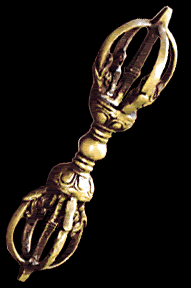Vajra
|
|
Vajra is a Sanskrit word meaning both thunderbolt and diamond and refers to a symbol important to both Hinduism and Buddhism.
The equivalent word in Tibetan is dorje, which is also a common male name in Tibet and Bhutan. Dorje can also refer to a small sceptre held in the right hand by Tibetan lamas during religious ceremonies.
In Hindu mythology the vajra is the thunderbolt weapon wielded by Indra, King of the Gods. In some stories it is made of bones from an ascetic. It represents various qualities: (1) it is indestructible, being the most powerful thing in the cosmos; (2) it cannot be used inappropriately; (3) it always returns to its wielder. The vajra represented the natural phenomenon of lightning, similar to the thunderbolt wielded by Zeus.
In Buddhism the vajra is the symbol of Vajrayana, one of the three major branches of Buddhism. Vajrayana is translated as "Thunderbolt Vehicle" or "Diamond Vehicle" and can imply the thunderbolt experience of Buddhist enlightenment or bodhi and also implies indestructibility, just as diamonds are harder than other gemstones.
In the tantric traditions of both Hinduism and Buddhism, the vajra is a symbol for the nature of reality, or sunyata, indicating endless creativity, potency, and skillful activity. The term is employed extensively in tantric literature: the term for the spiritual teacher is the vajracarya; instead of bodhisattva, we have vajrasattva, and so on. The practice of prefixing terms, names, places, and so on by vajra represents the conscious attempt to recognize the transcendental aspect of all phenomena; it became part of the process of "sacramentalizing" the activities of the spiritual practitioner and encouraged him to engage all his psychophysical energies in the spiritual life.
An instrument symbolizing vajra is also extensively used in the rituals of the tantra. It consists of a spherical central section, with two symmetrical sets of five prongs, which arc out from lotus blooms on either side of the sphere and come to a point at two points equidistant from the centre, thus giving it the appearance of a "diamond sceptre", which is how the term is sometimes translated.
Various figures in Tantric iconography are represented holding or wielding the vajra. Three of the most famous of these are Vajrasattva, Vajrapani, and Padmasambhava. Vajrasattva (lit. vajra-being) holds the vajra, in his right hand, to his heart. The figure of the Wrathful Vajrapani (lit. vajra in the hand) brandishes the vajra, in his right hand, above his head. Padmasambhava holds the vajra in front of him in his right hand.
Symbolism
The vajra is made up of several parts:
In the center is a sphere which represents sunyata, the primordial nature of the universe, the underlying unity of all things.
Emerging from the sphere are two eight petalled lotus flowers. One represents the phenomenal world (or in Buddhist terms samsara), the other represents the noumenal world (or Nirvana). This is one of the fundamental dichotomies which are perceived by the unenlightened.
Arranged equally around the mouth of the lotus are 2, 4, or 8 mythical creatures which are called makaras. These are half fish, half crocodile. In mythology fantastic creatures made up of two or more animals often represent the union of opposites, or a harmonisation of qualities that are transcend our usual experience.
From the mouths of the makaras come tongues which come together in a point.
The five pronged vajra (with four makaras, plus a central prong) is the most commonly seen vajra. There is an elaborate system of correspondences between the five elements of the noumenal side of the vajra, and the phenomenal side. One important correspondence is between the five 'poisons' with the five wisdoms. The five poisons are the mental states that obscure the original purity of a beings mind, while the five wisdoms are the five most important aspects of the enlightened mind. Each of the five wisdoms is also associated with a Buddha figure. (see also Five Wisdom Buddhas)
poison : wisdom (associated Buddha figure)
greed = wisdom of sameness (Amitabha)
hatred = mirror like Wisdom (Akshobhya)
delusion = reality wisdom (Vairocana)
pride = wisdom of individuality (Ratnasambhava)
envy = all accomplishing wisdom (Amoghasiddhi)
See also
External links
- Online exhibition of dorje artifacts (large download size) (http://drilbudorje.tripod.com/_Dorje.htm)
- Explanation of vajra and bell from Tibetan government website (http://www.tibet.com/Buddhism/3objects.html)

